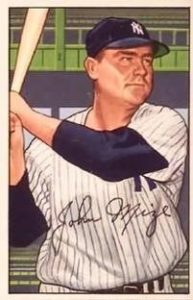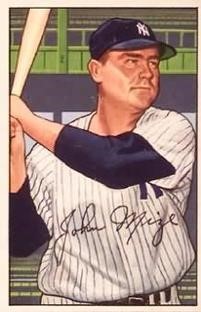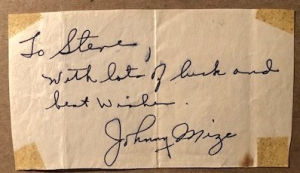September 7, 1952: Johnny Mize completes homer-in-every-ballpark with pinch-hit grand slam
“He is one batter who always knows what he is doing up at the plate and why.”1 — Tommy Henrich
 Johnny Mize, Hall of Fame first baseman, could hit a baseball and he wrote about it in How to Hit.2 The 1953 book, co-authored with Murray Kaufman, is an easy read for those of any age. In the foreword, Henrich, his former teammate, vouched for Mize’s qualifications. The Georgia native’s collection of bats was legendary, and SABR biographer Jerry Grillo noted that Mize knew how to use every one of them.3
Johnny Mize, Hall of Fame first baseman, could hit a baseball and he wrote about it in How to Hit.2 The 1953 book, co-authored with Murray Kaufman, is an easy read for those of any age. In the foreword, Henrich, his former teammate, vouched for Mize’s qualifications. The Georgia native’s collection of bats was legendary, and SABR biographer Jerry Grillo noted that Mize knew how to use every one of them.3
Like a schoolteacher, Mize summarized his written lesson. “Don’t forget to ‘stand in there’ against any pitcher. Don’t forget to keep saying you are going to get a hit. Don’t forget when you are hitting in the clutch, not to let the situation become too big for you.”4
When Mize reflected on his career, he understood that his best years as a hitter came with the St. Louis Cardinals and the New York Giants.5 For example, his 51 home runs for the Giants in 1947 were a National League record for left-handed hitters until Ryan Howard hit 58 in 2006 for the Philadelphia Phillies. But for Mize, his games of fondest memory as a hitter came as a New York Yankee in the later years of his career. After all, the Yankees won the World Series for the five years Mize played in the pinstripes (1949-1953).6
In his book, Mize recounted a particular at-bat he would always remember as the Yankees played the Washington Senators at Griffith Stadium for the last time in the 1952 season. And he wasn’t even in the starting lineup!
Washington manager Bucky Harris sent right-hander Walt Masterson (9-6, 3.95 ERA) to the mound for the Senators. The 32-year-old Masterson was on his second tour with Washington after a trade from the Boston Red Sox in June.7 In August alone, Masterson had pitched two complete-game victories over the Yankees. Yankees manager Casey Stengel countered with Eddie Lopat (7-5, 2.91 ERA), who had pitched a three-hit, complete-game 6-1 win over the Senators at Yankee Stadium in his last start, marred only by a ninth-inning home run by Eddie Yost.
This time around, Yost picked up where he left off against Lopat when he opened the bottom of the first with a single to center. When Jim Busby and Jackie Jensen followed with successive singles, the Senators led 1-0. But over the next five innings, Lopat was masterful and in control, limiting the Senators to a walk and two singles. Not a single Senator reached second base during that span.
Masterson was even better. He retired the first 13 batters he faced. Gene Woodling got the Yankees’ first hit, an infield single in the fifth, but was quickly erased on a double-play ball, third-to-second-to first.
But just as quickly, Masterson lost his control. He opened the sixth inning by walking Billy Martin and Phil Rizzuto. When Lopat attempted a sacrifice bunt with two strikes, first baseman Mickey Vernon fielded the ball, “then forgot what to do with it.”8 The bases were loaded with no outs.
And then, Stengel surprised everyone by sending Mize to the plate to pinch-hit for third baseman Gil McDougald. Was this one of Stengel’s “black magic” surprises, as New York Times sportswriter John Drebinger suggested?9 Perhaps Stengel was just remembering that barely one week earlier, Mize had pinch-hit a ninth-inning home run off Masterson the very last time they faced each other. You can be certain that Mize remembered that at-bat when he faced Masterson again.
On a count of two balls and one strike, Masterson threw a slider and Mize hit it deep to right field. Mize insisted that he would have settled for a long fly ball.10 Instead, his shot cleared the fence for a grand slam—the 354th home run of his career, the most of any active player at the time and sixth on the all-time list. The Yankees had surged ahead, 4-1.
When Mize returned to the bench, he realized what he had accomplished. The Big Cat had hit home runs in all 14 active major-league parks plus the then-abandoned Baker Bowl in Philadelphia, a feat believed to be without parallel in baseball history. Mize recalled that he had never even hit a batting-practice homer in Griffith Stadium and now he had achieved one of his career’s biggest thrills.11
The Yankees added another run in the sixth after the Mize grand slam to lead 5-1. With one out, Mickey Mantle singled to right, advanced to third on Yogi Berra’s single, and scored on an infield out.
The Yankees’ five-run sixth was all of their scoring and almost all of their offense in the game. Masterson retired the side in order in the seventh and Julio Moreno pitched the last two innings in relief, allowing only a single by Hank Bauer in the ninth.
Meanwhile, the Senators’ only scoring threat after their first-inning run came in the seventh. Pete Runnels singled to center and Vernon walked. Lopat struck out Mel Hoderlein for the first out. Mickey Grasso’s infield single loaded the bases so Harris sent Clyde Kluttz to pinch-hit for Masterson. Kluttz grounded into a double play, ending that threat.
Lopat coasted the rest of the way for his eighth win of the season. Since recovering from an arm injury, Lopat had now recorded his third complete-game victory in a row.12 Most importantly, he was back to contributing to another Yankees run to the World Series.
As the Yankees headed to St. Louis for a two-game series with the Browns, they were two games ahead of the second-place Cleveland Indians in the American League pennant chase, thanks to Lopat’s pitching and Mize’s grand slam. That is exactly how they finished the regular season three weeks later.
It wasn’t surprising that speculation about the 39-year-old Johnny Mize’s future in baseball was hitting the press in September as the regular season was ending. Dan Daniel’s take on that subject in The Sporting News was direct. “It is virtually certain that Big Jawn will retire as a player after his fortieth birthday, in January, if not sooner.”13 Drebinger had made the same point in the New York Times in the very first sentence of his account of this game against the Senators.14
Mize appeared in 52 games as a pinch-hitter in 1952, more times than in his three previous seasons with the Yankees combined, and he finished with 4 home runs and 29 runs batted in in just 78 games. Those numbers were all lows for a major-league career that began in 1936 with the Cardinals. Was this Mize’s last season?
First things first. There was a World Series to play, an opportunity that Johnny Mize cherished. Let’s just say that Mize loved to hit home runs and that his biggest thrill as a hitter lay ahead. The Yankees won the World Series in seven games against the Brooklyn Dodgers. Mize had three home runs—and nearly a fourth if it wasn’t for a great catch by Carl Furillo in the 11th inning of Game Five.15 His .400 batting average (6-for-15) was the highest of any player in the Series. “Not Bad for a Kid, Says Amazing Mize” was the banner headline in The Sporting News.16
Mize was driven by two ambitions, both bearing on the great Joe DiMaggio’s records as a Yankee. Mize finished the 1952 season with 1,985 hits and 355 home runs. DiMaggio retired after the 1951 season with 2,214 hits as well as 361 home runs. Mize wanted to reach 2,000 hits and 362 home runs before he retired. Cartoonist Willard Mullin sketched the caricature of Mize and his ambitions, “No, ’tis not so many as Joe; Nor so big as DiMaggio’s … But ’tis enough, ’twill serve. …”17
To no one’s surprise, Big Jawn would return to the Yankees in 1953 for one final season.
Author’s note
Why write essays about Johnny Mize? After all, the author was a childhood fan of the Brooklyn Dodgers. Baseball fans of any age always remember that first autograph secured on a ball, on a cap, on a card, or even on a scrap of paper. It’s a story already told.18 Thank you, Mr. Mize.
Acknowledgments
This essay was fact-checked by Kevin Larkin and copy-edited by Len Levin.
Sources
The author accessed Retrosheet.org (retrosheet.org/boxesetc/1952/B09070WS11952.htm) and Baseball-Reference.com (baseball-reference.com/boxes/WS1/WS1195209070.shtml) for box scores/play-by-play and other data. The Johnny Mize baseball card (1952 Bowman #145) was obtained from the Trading Card Database.
Notes
1 Johnny Mize to Murray Kaufman, How to Hit (New York: Henry Holt and Company, 1953), v.
2 Mize.
3 Jerry Grillo, “Johnny Mize,” SABR Baseball Biography Project.
4 How to Hit, 103. Chapter 14 provides three pages of “Don’t Forget” for the reader.
5 Johnny Mize to George Vass, “The Game I’ll Never Forget,” Baseball Digest, March 1979: 74.
6 Paul Dickson, The Dickson Baseball Dictionary, Third Edition (New York: W.W. Norton & Company, 2009), 640. Pinstripes is a nickname for the New York Yankees.
7 On June 13, 1949, the Senators traded Masterson to the Boston Red Sox for Mickey Harris and Sam Mele. On June 10, 1952, the Red Sox sent Masterson back to the Senators along with Randy Gumpert in exchange for Sid Hudson in a trade of pitchers.
8 John Drebinger, “Bombers Triumph Behind Lopat, 5-1,” New York Times, September 8, 1952: 26.
9 Drebinger.
10 How to Hit, 98.
11 How to Hit.
12 Drebinger.
13 Dan Daniel, “Mize Has Belted Homer in Every Park in Majors,” The Sporting News, September 17, 1952: 7.
14 Drebinger. “Big Jawn Mize, 39 years of age and probably trouping around the major circuit for the last time, …”
15 John Drebinger, “Dodgers Defeat Yankees, 6-5, in the 11th; Lead Series, 3-2; Snider and Erskine Star,” New York Times, October 6, 1952: 1.
16 The Sporting News, October 15, 1952: 3.
17 Willard Mullin, “The Big Cat That Came Back,” The Sporting News, October 15, 1952: 3.
18 Steven C. Weiner, “July 18, 1950: Johnny Mize homers twice, Yankees crush Browns,” SABR Baseball Games Project.
Additional Stats
New York Yankees 5
Washington Senators 1
Griffith Stadium
Washington, DC
Box Score + PBP:
Corrections? Additions?
If you can help us improve this game story, contact us.



